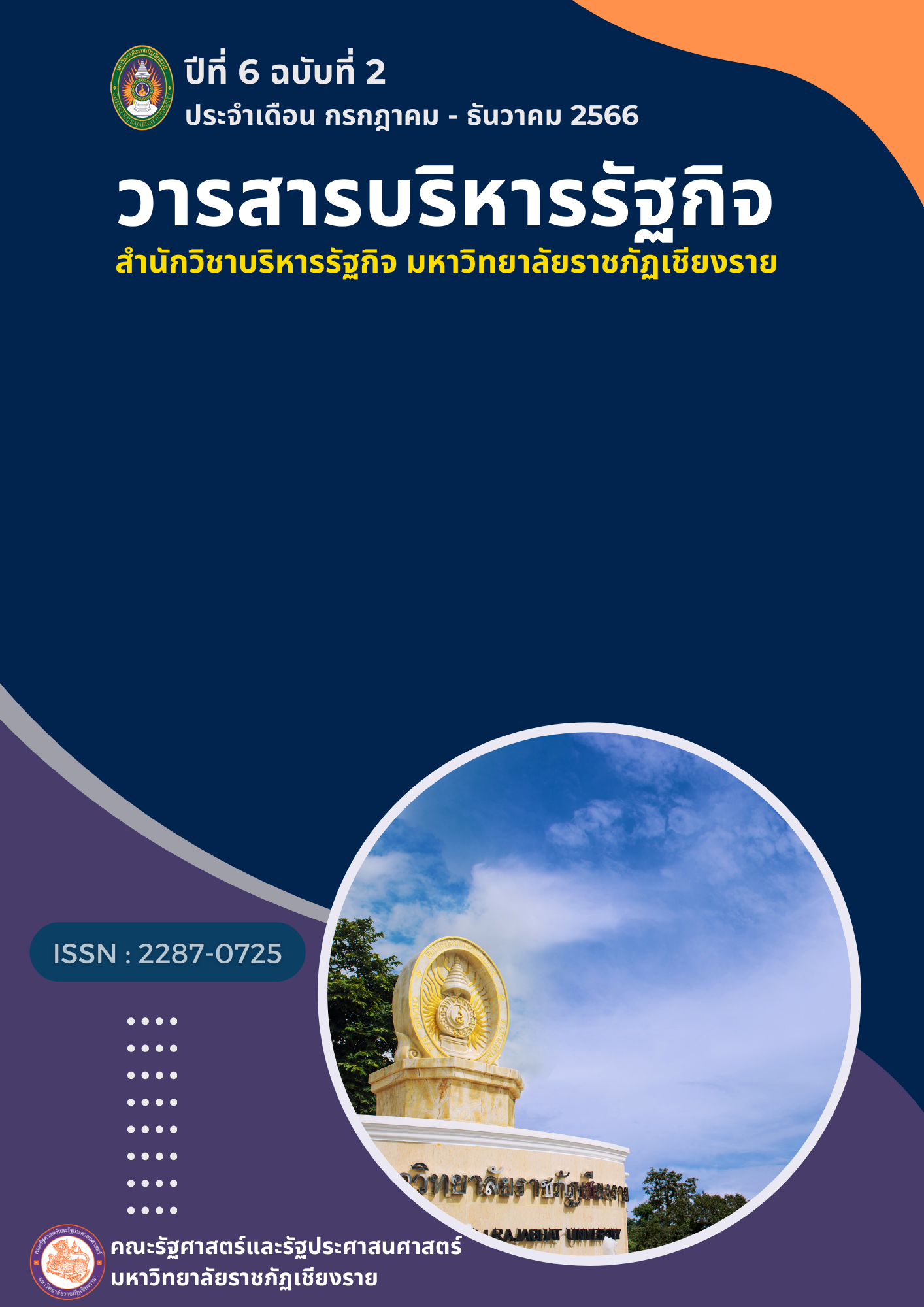Components of Integrated Management
Main Article Content
Abstract
The components of integrated management used in this article refer to the opinions of the sample on management or the implementation of the integrated administration in the provision of public services, approaches for participating in the partnership between the public and private sectors in the Eastern Special Development Zone project Able to operate and achieve objectives that are in a direction that is conducive to the benefit of the people and the nation. The author of the article has synthesized the variables into 7 variables: Component 1, Organizational (Organizing), Component 2, Policy (Policy) Component 3, Personnel Management (Staff), Component 4, Management Behavior (Style) Component 5, System and Operation Method Component 6 Shared values and Component 7 Skills.
Article Details
References
ฉัตรณรงค์ ฉัตรภูติ. (2560). การบริหารจัดการขององค์การบริหารส่วนจังหวัดชัยภูมิ ตามแนวคิดของสำนักงานคณะกรรมการพัฒนาระบบราชการ. ดุษฎีนิพนธ์ ปรัชญาดุษฎีบัณฑิต สาขาวิชารัฐประศาสนศาสตร์, มหาวิทยาลัยอีสเทิร์นเอเชีย.
ปาริชาติ เข่งแก้ว. (2563). แนวทางการบริหารสถานศึกษาโดยใช้กระบวนการชุมชนแห่งการเรียนรู้ทางวิชาชีพ สังกัดสำนักงานเขตพื้นที่การศึกษาประถมศึกษาเพชรบูรณ์ เขต 3. Journal of Legal Entity Management and Local Innovation, 6(5), 335-345.
พัทธ์ยมล สื่อสวัสดิ์วณิชย์. (2558). ต้นแบบการบริหารจัดการธุรกิจการท่องเที่ยวเชิงเกษตรอย่างมีประสิทธิภาพ
ในภาคตะวันออกของประเทศไทย. ดุษฎีนิพนธ์ ปรัชญาดุษฎีบัณฑิต สาขาวิชาการจัดการ มหาวิทยาลัยสยาม.
พิชญาภา ยืนยาว. (2562). ตำราภาวะผู้นำทางการบริหารการศึกษาและสถานศึกษา. นครปฐม : โครงการตำรามหาวิทยาลัยราชภัฏนครปฐม.
ยงยุทธ ยะบุญธง. (2564). การบริหารสถานศึกษาแห่งการสร้างสรรค์นวัตกรรม. กรุงเทพฯ: (อยู่ระหว่างการดำเนินการจัดพิมพ์).
ราชบัณฑิตยสถาน. (2546). พจนานุกรมฉบับราชบัณฑิตยสถาน พ.ศ. 2542. กรุงเทพฯ: นานมีบุคส์ พับลิเคชั่นส์.
วิรัช วิรัชนิภาวรรณ. (2555). การบริหารจัดการและการบริหารยุทธศาสตร์ของหน่วยงานของรัฐ. กรุงเทพฯ: โฟรเพช.
ศุภชัยยาวะประภาษ. (2548). การบริหารงานบุคคลภาครัฐไทย: กระแสใหม่และสิ่งท้าทาย. กรุงเทพฯ: จุดทอง.
สำนักงาน ก.พ. (2556). การวางแผนทางก้าวหน้าในสายอาชีพ (พิมพ์ครั้งที่ 1). นนทบุรี: บริษัท อัพทรูยูครีเอทนิว จำกัด.
สำนักงานคณะกรรมการพัฒนาระบบราชการ. (2556). คู่มือเทคนิคและวิธีการบริหารจัดการสมัยใหม่ ตามแนวทางการบริหารกิจการบ้านเมืองที่ดี การบริหารราชการแบบบูรณาการ. กรุงเทพ ฯ: สำนักงานคณะกรรมการพัฒนาระบบราชการ (สำนักงาน ก.พ.ร.).
อุทัย เลาหวิเชียร. (2559). ค่านิยมของการบริหารงาน. กรุงเทพฯ: สำนักพิมพ์เสมาธรรม.
Amorim, P., Gunther, H. O., & Almada–Lobo, B. (2012). Multi-objectiveintegration production and distribution planning of perishable products. International Journal of Production Economics, 138(1), 89-101.
Everard, K.B., Morris, G. and Wilson, Ian. (2004). Effective School Management (4thed.). Sage Publication.
George, J.M.,and Jones, G.R. (1999). Understanding and managing: Organizational Behavior (2nd ed.). Massachusetts: Addison – Wesley.
Hoy, W. K., & Miskel, C. G. (1993). Educational administration. New York: McGraw-Hill, Inc.
Kaplan, R. S., & Norton, D. P. (2008). The execution premium. Boston, MA: Harvard Business School.
Peters, T., & Waterman, R. H. (2010). In Search of Excellence: Lessons from America’s Best-Run Companies. New York: Harper & Row.
Porter, M. E. (2001). The value chain and competitive advantage. Understanding Business Processes. New York: Free Press.
Scholtes, P. R. (1998). The leader’s handoffs making things happen, gettingthings done. New York: McGraw–Hill.


